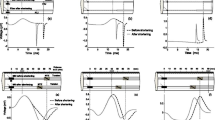Abstract
The passive membrane capacitance and conductance of isolated single muscle fibers were investigated using a vaseline gap method. The results obtained with this method are consistent with those obtained using the microelectrode technique. It was confirmed that the membrane capacitance of skeletal muscle consisted of a large capacitance of tubular membrane (7–10 μF/cm2) and a much smaller capacitance of surface membrane (1–2 μF/cm2). The relative time constants of these two components vary from one sample to another, resulting in one time and two time constant behaviors.
Secondly, the capacitance of isolated skeletal muscle fibers was investigated during hyper- and depolarizing pulses, using the transient bridge technique with the vaseline gap method. Measurements were performed at two frequencies, i.e. 500 Hz and 20 kHz. It was found that the membrane capacitance increased by 15–20% with depolarizations. The voltage dependent membrane capacitance was no affected by the addition of tetrodotoxin in bathing solution blocking sodium current and muscle contraction. Also, blocking both Na and K current did not have an appreciable effect on the non-linear behavior of membrane capacitance. The origin of voltage dependent capacitance in muscle membrane appears to be distributed among several non-linear ionic processes such as Na and K currents and the flux of Ca and Cl ions and their accumulation.
Similar content being viewed by others
References
Adrian RH, Almers W (1976a) The voltage dependence of membrane capacity. J Physiol (Lond) 254:317–338
Adrian RH, Almers W (1976b) Charge movement in the membrane of striated muscle. J Physiol (Lond), 254:339–360
Almers W (1978) Gating currents and charge movements in excitable membranes. Rev Physiol Biochem Pharmacol 82:96–190
Armstrong CM, Bezanilla F (1973) Currents related to movement of the gating particles of the sodium channels. Nature (Lond) 242:459–461
Armstrong CM, Bezanilla F (1974) Charge movement associated with the opening and closing of the activation gates of the Na channels. J Gen Physiol 63:533–552
Ashcroft FM, Stanfield PR (1981) Calcium dependence of the inactivation of calcium currents in skeletal muscle fibers of an insect. Science 213:224–226
Campbell DT (1983) Sodium channel gating currents in frog skeletal muscle. J Gen Physiol 82:679–701
Eisenberg RS, Gage PW (1967) Frog skeletal muscle fibers; changes in electrical properties after disruption of transverse tubular system. Science 158:1700–1701
Eisenberg B, Eisenberg RS (1968) Selective disruption of the sacrotubular system in frog sartorius muscle. J Cell Biology 39: 451–467
Falk G, Fatt P (1964) Linear electrical properties of striated muscle fibers observed with intracellular electrodes. Proc Roy Soc Ser B 160:69–123
Fernandez JM, Bezanilla F, Taylor RE (1982) Distribution and kinetics of membrane dielectric polarization. J Gen Physiol 79:41–67
Fishman HM, Moore LE, Poussart D, Leuchtag HR, Sanchez J (1977) No capacitance increase in squid axon admittance when “inactivation” of “gating charge” is insufficient. Biophys J 33: 281a
Freygang WH, Jr, Rapopport SI, Peachey LD (1967) Some relations between changes in the linear electrical properties of striated muscle fibers and changes in ultrastructure. J Gen Physiol 50:2437–2458
Gage PW, Eisenberg RS (1969a) Capacitance of the surface and transverse tubular membrane of frog sartorius fibers. J Gen Physiol 59:347–359
Gage PW, Eisenberg RS (1969b) Action potentials, afterpotentials and excitation-contraction coupling in frog sartorious fibers without transverse tubules. J Gen Physiol 56:640–671
Guttman R (1939) The electrical impedance of muscle during the action of narcotics and other agents. J Gen Physiol 22:567–591
Hille B, Cambell DT (1976) An improved vaseline gap voltage clamp for skeletal muscle fibers. J Gen Physiol 67:265–293
Hodgkin AL, Huxley AF (1952) A quantitative description of membrane current and its application to conduction and excitation in nerve. J Physiol (Lond) 117:500–544
Hodgkin AL, Nakajima S (1972) The effect of diameter on the electrical constants of skeletal frog muscle fibers. J Physiol 221:105–120
Horowicz P, Schneider MF (1981) Membrane charge movement in contracting and non-contracting skeletal muscle fibers. J Physiol 314:565–593
Huang CLH (1981a) Dielectric components of charge movements in skeletal muscle. J Physiol 313:187–205
Huang CLH (1981b) Membrane capacitance in hyperpolarized muscle fibers. J Physiol 313:206–222
Keynes RD, Rojas E (1976) Kinetics and steady-state properties of the system controlling sodium conductance in the squid giant axon. J Physiol 239:393–434
Meves H (1976) The effect of molding potential on the asymmetry currents in squid giant axons. J Physiol 254:787–801
Meves H (1977) Activation, inactivation and chemical blockade of the gating current in squid giant axons. Ann NY Acad Sci 303:321–388
Schneider MF, Chandler WK (1973) Voltage-dependent charge movement in skeletal muscle: A possible step in excitation-contraction coupling. Nature (Lond) 242:244–246
Schneider MF, Chandler WK (1976) Effects of membrane potential on the capacitance of skeletal muscle fibers. J Physiol 67:125–163
Schwan HP (1954) Die elektrischen Eigenschaften von Muskelgewebe bei Niederfrequenz. A Naturforsch 9b:245–251
Takashima S (1978) Frequency domain analysis of asymmetry current in squid axon membrane. Biophys J 22:115–119
Takashima S, Yantorno R (1977) Investigation of voltage-dependent membrane capacity of squid giant axons. Ann NY Acad Sci 303:306–321
Takashima S, Schwan HP (1974) Passive electrical properties of squid axon membrane. J Membrane Biol 17:51–68
Author information
Authors and Affiliations
Rights and permissions
About this article
Cite this article
Takashima, S. Passive electrical properties and voltage dependent membrane capacitance of single skeletal muscle fibers. Pflugers Arch. 403, 197–204 (1985). https://doi.org/10.1007/BF00584100
Received:
Accepted:
Issue Date:
DOI: https://doi.org/10.1007/BF00584100




